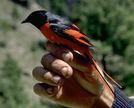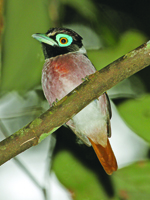
Campephaga lobata
TAXONOMY
Ceblepyris lobatus Temminck, 1824, Gold Coast (Ghana).
OTHER COMMON NAMES
English: Ghana cuckoo-shrike; French: Echenilleur а barbillons;
German: Westlicher lappenraupenfresser; Spanish:
Oruguero Occidental.
PHYSICAL CHARACTERISTICS
8.3 in (21 cm); 1.0–1.3 oz (29–37 g). Male has glossy black
head and black bill with orange wattles on gape. Breast and
flanks orange-yellow, wings greenish yellow. Female slightly
duller with greenish forehead and crown.
DISTRIBUTION
East Sierra Leone, Liberia, west Cфte d’Ivoire, south Ghana,
one record in southeast Nigeria.
HABITAT
Upper Guinea forest zone, in the canopy of primary or tall
lowland rainforest, often near rivers, and in open swamp-forest.
Also recorded in logged forest, Terminalia plantations, disturbed
forest, and managed forest.
BEHAVIOR
Usually seen singly or in pairs, often with a mixed bird party;
inconspicuous.
FEEDING ECOLOGY AND DIET
The diet includes caterpillars, grasshoppers, mantids, and seeds.
REPRODUCTIVE BIOLOGY
Descriptions of the nest and eggs are not available. Birds from
Liberia are known to be in breeding condition in February and
during the months of August to November.
CONSERVATION STATUS
Although it has apparently adapted to secondary habitat, this
bird is seriously threatened by massive forest destruction
throughout its range. It is therefore considered Vulnerable. In
2000, it was locally rare to uncommon over much of its range.
SIGNIFICANCE TO HUMANS
None known.
Photo Gallery of - Western wattled cuckoo-shrike




 Animalia Life
Animalia Life